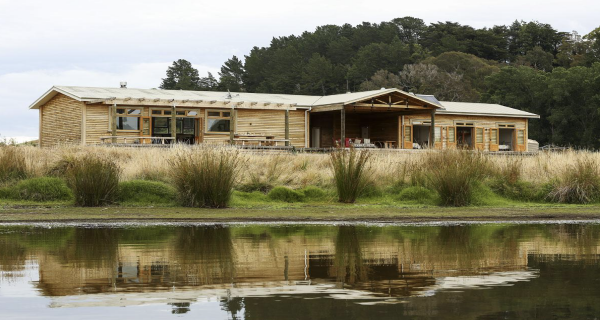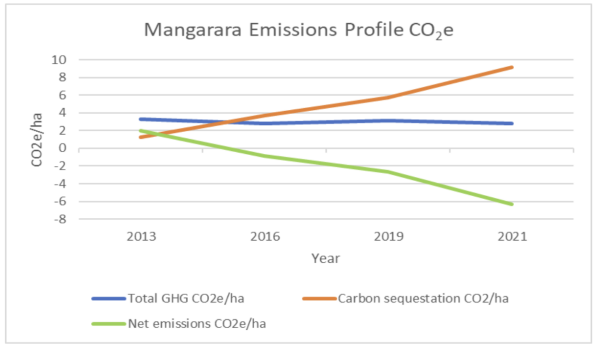Mangarara Farm - Greg and Rachel Hart, Elsthorpe
Mangarara Farm is a 600-hectare (465 ha effective) hill country property situated in Elsthorpe, in central Hawke’s Bay. The property is jointly owned by the Hart family and the Future Farming Syndicate.
Video
Overview
The journey for the Harts has been a gradual transition over 20 years away from a typical hill
country sheep breeding unit to a finishing system that supplies regeneratively farmed beef to butchers in Auckland and Hawke’s Bay. The farm is also home to Mangarara Eco Lodge which is nestled on the shores of the 35-hectare Horseshoe Lake.
Mangarara is known for innovative integration of trees using silvopasture, which consists primarily of trees planted throughout the grazing platform. There is a focus on animal welfare, with plantings providing shade and shelter. Trees also contribute to nutrient recycling and are a source of livestock fodder during periods of drought. In the future there is the potential of income from timber and an opportunity to sell carbon, in secondary markets, to organisations looking for carbon credits.
Mangarara will reach carbon zero status in 2025, with a long-term goal of sequestering five times more carbon than the farm emits.
What changes have been made?
Over the past decade sheep numbers have declined and the farm has moved to a regeneratively farmed beef operation (Table 1)
Table 1: Mangarara physical parameters
| 2013 | 2016 | 2019 | 2021 | |
| Effective area (ha) | 465 | 465 | 465 | 489 |
| Breeding ewes | 1,013 | 690 | 129 | 10 |
| Breeding cows | 17 | 124 | 99 | 119 |
| R1 heifers | 197 | 99 | 639 | 230 |
| R2 heifers | 17 | 9 | 169 | 104 |
| R2 steers | 85 | 0 | 0 | 85 |
| R1 bulls | 0 | 0 | 21 | 104 |
| Total stock units (SU) | 4,325 | 3,674 | 3,999 | 3,765 |
| SU/ha | 9.3 | 7.9 | 8.6 | 7.7 |
Plantings include one of the first Air New Zealand projects and have continually grown to now comprise 21 hectares of new native plantings, 52 hectares of exotic trees, 13 hectares of existing native forest, a Million Metre Stream project to plant the riparian margin of Horseshoe Lake, and 45 hectares in silvopasture.
As less productive areas of the farm have been taken out of the grazing platform, Greg and
Rachel have looked to where they can add value elsewhere in the business. The regenerative beef supply contract is one example of this.
Diversification into silvopasture enables cattle to access better quality pasture, shade and shelter while grazing, resulting in lower stress levels and increased liveweight gains. This has enabled efficiencies within the farm system at the same time as reducing greenhouse gas emissions. During adverse climatic conditions such as drought, the established silvopasture trees are an additional source of animal fodder.
The major non-farm system diversification has been the establishment of an Eco Lodge in 2015. This venue is used for accommodation, weddings, workshops, and educational days. Greg says “we get back much more than we give” by having the lodge.

The final change was to the ownership structure, replacing bank debt with funding from The Future Farming Syndicate. This has allowed fast tracking of several visions Greg and Rachel have for the farm. Examples of this include the newly established solar reticulated water system and the acceleration of the silvopasture programme.
What have been the impacts of the changes?
The reduction in stock numbers since 2013 has resulted in a 14 percent reduction in gross greenhouse gas emissions per hectare, and a 10 percent reduction in gross emissions across the whole farm. Coupled with this, the carbon sequestration from the forestry plantings, when used as an offset, means that net emissions from the farm are negative. As shown in Table 2, the farm is approximately twice carbon negative.
Table 2: Mangarara biological GHG emissions
|
2013 |
2016 |
2019 |
2021 |
2021 vs 2013 |
|
|
Methane (t C0₂e/ha) |
2.69 |
2.30 |
2.55 |
2.32 |
-14% |
|
Nitrous oxide (t C0₂e/ha) |
0.59 |
0.50 |
0.56 |
0.50 |
-13% |
|
Total GHG (t C0₂e/ha) |
3.29 |
2.80 |
3.10 |
2.82 |
-14% |
|
Carbon sequestration (t CO₂e/ha) |
1.27 |
3.67 |
5.74 |
9.16 |
+787% |
|
Net emissions from the farm (t CO₂e/ha |
2.02 |
-0.87 |
-2.64 |
-6.34 |
-315% |
Figure 1: Mangarara GHG emissions

NOTE: Plantings such as the Air New Zealand project and fruit and nut trees are not eligible for the ETS and have not been included in the table.
The new, regenerative grazing system has seen a 15 percent reduction in nutrient losses for
Mangarara, (as modelled by Overseer) and this has resulted in reduced fertiliser inputs. Current maintenance fertiliser requirements are around half of those required under the original ewe breeding policy.
What process did they go through to make the changes?
There have been two key areas of change for Mangarara. The first has focused on changes to the biological system and how livestock and land use management are integrated in a diverse landscape. The second area of change has focused on diversification of income streams and adding value.
The first step was questioning the status quo farming system and adopting a mindset for change. Lots of education and learning has enabled incremental changes to transition from a conventional farming system to a regenerative one, while maintaining profitability.
Changing the biological system has required changes to farm management policies. For example, the change out of breeding ewes into a predominantly finishing policy, with a large cattle component, meant that a change to grazing management was required. Higher pre and post grazing pasture covers are utilised by rotational grazing with high stocking intensities.
The change in thinking was centred on the future that Greg and Rachel wanted for their children. The Harts see a different long-term future for conventional agriculture in Aotearoa New Zealand. Mangarara’s goal was to reduce energy and resource consumption while strengthening resilience to adverse climatic and market conditions, all the while maintaining profitability to allow investment back into the farm and reduction of debt.
Because the regenerative agriculture debate wasn’t front of mind for most when Greg and Rachel looked to make changes to their farm system, it was very much a learn and experiment approach. This has now got them to the farm system they run on Mangarara. Going forward, further diversification is planned, along with a continuation of what has been working to date.
The motivation for the tree planting was based around knowing that New Zealand was once largely forested and how removing the forests had changed hydrological cycles and increased erosion. That led the Harts to try to restore the balance between nature and food production. Their interest in silvopasture was further reinforced during their participation in a local farmer group looking at ways to improve resilience to climate change. Since 2008, they have planted 135,000 trees on-farm, the majority of these being New Zealand native species, with a diverse mix of fruit and nut trees also included to add food production to the mix.
Trees have been planted for erosion control, shade and shelter, biodiversity, timber, carbon sequestering and for aesthetics, with the long-term goal of making Mangarara a beautiful, productive, and profitable place to live and work.
What other changes are planned?
Profitability will drive the implementation of future planned works. In Greg’s words, “constraint is only limited by imagination and courage”.
The damage to the hill country from Cyclone Gabrielle in early 2023 has seen Mangarara pivot to establishing native plantings on erosion damaged areas in the short to medium term, for example the establishment of 16,000 native plants on class 6 and 7 hills.
What advice do they have for other farmers?
- Embrace and be comfortable with change - farming is a lifelong learning journey.
- Understand as farmers we are part of a living system.
- Figure out what is really important in life - take the time to be still. Listen to your heart, take time to figure it out and trust the journey.
- Aim to understand what is sustainable. We must regenerate ecosystems, and how and where we grow food is the key. Understand as land stewards we can and must have a positive regenerative impact on the environment.
While the Harts feel their farming system is far from being fully regenerative, they believe an evolutionary paradigm shift to living in harmony with the environment is possible.
Published: July 22, 2025

